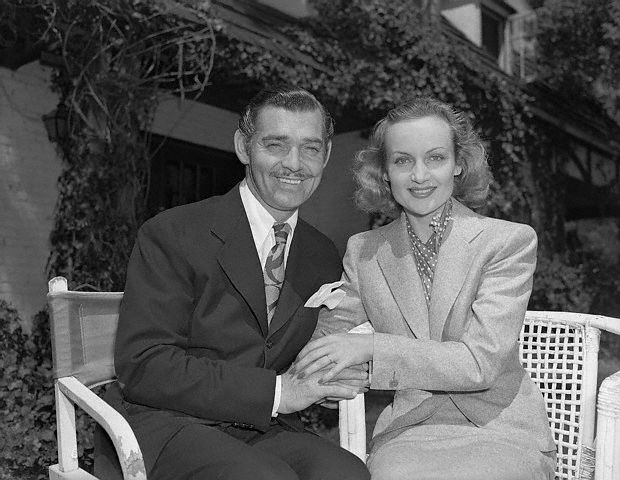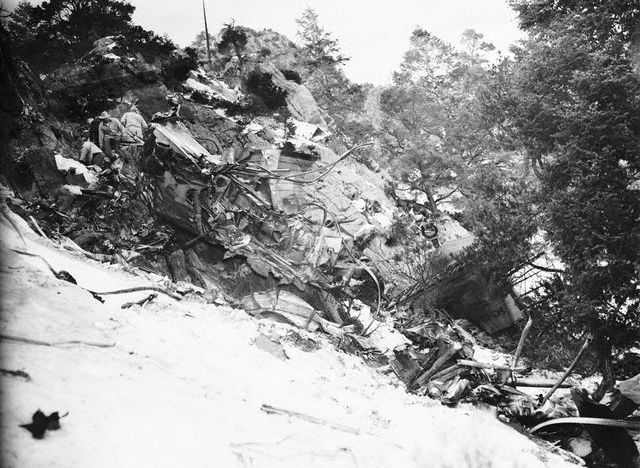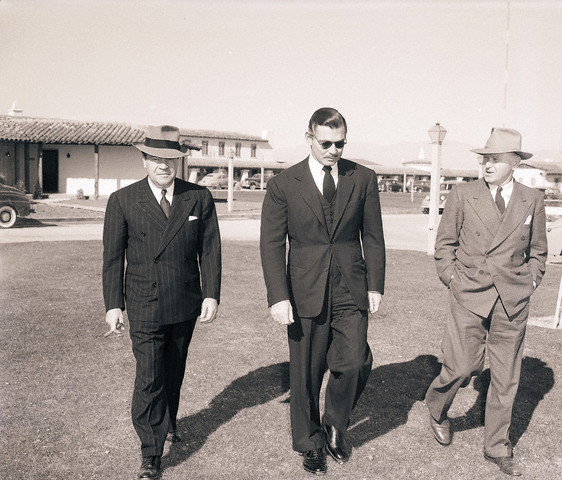Bright Lights, Bright People Near Las Vegas, Nevada January 16th, 1942  Carole Lombard had been traveling cross-country, promoting defense bonds to finance America's entry into the Second World War just six weeks earlier. The trip, an idea of her equally-celebrity husband Clark Gable, who was chairman of an actors' committee handling personal appearances to boost bond sales, was to Lombard's home state of Indiana. The end of her tour came in Indianapolis, where she had lent a hand at flag-raisings, led a rally at the city's Cadle Tabernacle, and raised nearly $2.5 million in a single day – deeming her “Defense Bond Saleslady No. 1.” Carole Lombard had been traveling cross-country, promoting defense bonds to finance America's entry into the Second World War just six weeks earlier. The trip, an idea of her equally-celebrity husband Clark Gable, who was chairman of an actors' committee handling personal appearances to boost bond sales, was to Lombard's home state of Indiana. The end of her tour came in Indianapolis, where she had lent a hand at flag-raisings, led a rally at the city's Cadle Tabernacle, and raised nearly $2.5 million in a single day – deeming her “Defense Bond Saleslady No. 1.”
The Flip of a Coin... At 4 in the morning, Lombard and her entourage, consisting of her mother, Mrs. Elizabeth Peters, and her press agent, Otto Winkler, arrived at the airport in Indianapolis. Tired, and with no sleeping berths on the Douglas DC-3, registered as NC1946 and flying as Transcontinental and Western Air Flight #3, that was traveling from New York City to Los Angeles overnight, Winkler wanted to go to a hotel, sleep, take a train, as they had on the trip to Indiana. But Lombard nixed the idea, saying "I'll curl up and take a pill and - pff - I'll be asleep..." The fate of the journey was determined by a coin flip – which Winkler lost. The trio boarded the plane, and it continued onwards to the southwest. The plane made several stops throughout the Midwest, including Saint Louis, Missouri, where the flight's takeoff was delayed due to weather. It continued on to and stopped at Albuquerque, New Mexico, where several Army officers and enlisted were to board the crowded civilian plane, and had orders justifying their ability to “bump” any civilians off. Several passengers, including violinist Joseph Szigeti, patriotically gave up their seats for the soldiers, but Lombard argued that having just sold over two million dollars' worth of war bonds, she must have some "rank." The Army officials gave in, permitting Lombard and her party continue on the flight, which left Albuquerque at 4:40 PM, local time, with a new flight crew. The flight was regularly scheduled to operate between Albuquerque, New Mexico, and Burbank, California, without any intermediate stops. But, due to reduced fuel load because of the Army personnel aboard, and the reported head winds over the airways, it was planned, however, that this flight should make intermediate stops at Winslow, Arizona, and Las Vegas, Nevada. Before continuing on to Winslow, Arizona, Winkler wired MGM that they would be an hour late arriving at Burbank, and the studio made arrangements to have Larry Barbier, an MGM public relations man, meet the plane. However, the headwind conditions were favorable that day, at 5:38, the flight crew elected to forego landing at Winslow. And since night landings were not available in Boulder City, Nevada, the DC-3, powered with two 1200-horsepower Wright Cyclone G202A engines, diverted to land in Las Vegas as its final stop at 6:36 in the evening before heading to its final destination of Burbank, near Los Angeles. At 7:07 PM, Flight 3 took off again - at the controls was 12,000-hour veteran pilot Captain Wayne C. Williams and co-pilot First Officer Morgan A. Gillette, a commercial pilot with over 1,300 flight hours – in the clear night skies. Some twenty minutes later, miners in the mountains west of Las Vegas heard a terrific explosion, and saw a vivid flash near the top of Table Rock Mountain. A ball of fire rose from the near the summit of Mount Potosi, and then disappeared.  Searchers, including those from the United States Army and Deputy Sheriffs of Clark County, Nevada, commenced a search for the airplane, and were bogged down due to the snowy mountainside. Because of the inaccessibility of the crash site, the wreckage was not reached until about 9:00 o'clock on the morning following the accident. Those on the scene envisioned that the transport had smacked straight into the mountain's steep wall, only 200 feet below the peak, then had slid, broken, into a ravine. For yards around, the scattered pine trees were scarred, the snow melted clean away. The wreckage was quickly placed under guard by deputy sheriffs until the following morning when a military guard, led by Major Herbert Anderson – the commander of the Army's nearby gunnery school - was established. Searchers, including those from the United States Army and Deputy Sheriffs of Clark County, Nevada, commenced a search for the airplane, and were bogged down due to the snowy mountainside. Because of the inaccessibility of the crash site, the wreckage was not reached until about 9:00 o'clock on the morning following the accident. Those on the scene envisioned that the transport had smacked straight into the mountain's steep wall, only 200 feet below the peak, then had slid, broken, into a ravine. For yards around, the scattered pine trees were scarred, the snow melted clean away. The wreckage was quickly placed under guard by deputy sheriffs until the following morning when a military guard, led by Major Herbert Anderson – the commander of the Army's nearby gunnery school - was established.
The Reaction in Tinseltown Barbier, waiting at Burbank, was one of the first to hear that TWA Flight 3 had crashed. He immediately called another MGM publicist, Howard Strickling, who was also a friend of Clark Gable. Strickling told Barbier to charter a plane; then he called Gable, who immediately left for the airport with MGM executive Ralph Wheelright. Jill Winkler, Lombard's brothers Stuart and Fred Peters, and Fred's wife, all left for Las Vegas by car, while MGM executive Eddie Mannix took a scheduled flight.  On the chartered flight to Vegas, Strickling would later recall that Gable was tense "because he sensed what had happened... You knew you shouldn't talk to him. You knew not to say, "It's going to be all right," or "I'm sorry."” When Gable and his group finally reached the base of the mountain, he wanted to go with the second search group, which included stretcher-bearers and medical supplies, but was persuaded to stay behind. Mannix and Wheelright, however, did go in Gable's stead. On the chartered flight to Vegas, Strickling would later recall that Gable was tense "because he sensed what had happened... You knew you shouldn't talk to him. You knew not to say, "It's going to be all right," or "I'm sorry."” When Gable and his group finally reached the base of the mountain, he wanted to go with the second search group, which included stretcher-bearers and medical supplies, but was persuaded to stay behind. Mannix and Wheelright, however, did go in Gable's stead.
The distraught actor paced a hotel room for hours awaiting word from searchers and finally set off soon after noon with Sheriff Ward for the crash site. However, word of finding the fate of the plane's crew and passengers came to Gable as he arrived at the base of the mountain, and he returned heartbroken to his hotel. Mannix later stated that he had seen Lombard's burned and headless body. Gable rode on the train that carried the bodies back to Los Angeles and then purchased three crypts at Forest Lawn cemetery, one for Carole, one for her mother, and one for himself: The Army offered to give Carole a military funeral, and the Hollywood Victory Committee wanted to build a monument honoring the first star to give her life for her country. But Gable refused both suggestions, explicitly carrying out his wife's funeral instruction: I request that no person other than my immediate family and the persons who shall prepare my remains for interment be permitted to view my remains after death has been pronounced. I further request a private funeral and that I be clothed in white and placed in a modestly priced crypt in Forest Lawn Memorial Park, Glendale, California. Every Hollywood studio are shut down for a day in a gesture of mourning. President Franklin D. Roosevelt saluted the blond, 33-year-old specialist in "screwball" comedy as a national heroine, and named her the first woman homefront fatality of the war. Shortly after her death, Gable, who was inconsolable and devastated by her loss, joined the United States Army Air Forces. After officers training, Gable headed a six-man motion picture unit attached to a B-17 bomb group in England to film aerial gunners in combat, flying five missions himself. Gable attended the launch of the Liberty ship, SS Lombard, named in her honor, on January 15, 1944. The Civil Aeronautics Board determined, in its report issued in July of 1942, that the probable cause of the accident was the failure of the captain after departure from Las Vegas to follow the proper course by making use of the navigational facilities available to him, and that contributing to the accident were the use of an erroneous compass course, the blackout of most of the beacons in the neighborhood of the accident made necessary by the war emergency, and the failure of the pilot to comply with requests that pilots to confine their flight movements to the actual on-course signals. |
